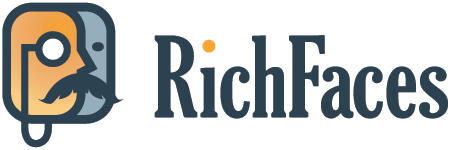The RichFaces project is an advanced UI component framework for easily integrating Ajax capabilities into business applications using JSF. Richfaces is distributed under LGPL v2.1.
This is a fork of the unmaintained Richfaces 4.5. Richfaces End of Life was June 2016. more info about Richfaces End of Life
List of vulnerabilities fixed
- CVE-2013-2165 Fixed in 4.3.3 and 3.3.4
- CVE-2018-14667 Fixed in 4.0.0
- CVE-2015-0279 Fixed in 4.5.5
- CVE-2018-12533 Fixed in 4.0.0
- CVE-2014-0086 Fixed in 4.3.6
- CVE-2018-12532 Fixed in 4.6.4.ayg 2018-08-21
To use the RichFaces framework in your JSF maven application, simply add the following dependency to your pom.xml file:
<dependency>
<groupId>com.github.albfernandez.richfaces</groupId>
<artifactId>richfaces</artifactId>
<version>4.6.21.ayg</version>
</dependency>Prior releases of RichFaces required using a BOM to manage the project dependencies. With RichFaces 4.5 all required dependencies are managed transitively, simplifying your project setup.
Alternatively, if you are not using maven, you can download the project ZIP distribution from the Download Page and manually include the dependencies in your classpath.
Once you have included the RichFaces dependency in your application, you can start developing by adding a JSF page which includes the RichFaces taglib references:
<!DOCTYPE html>
<html lang="en"
xmlns="http://www.w3.org/1999/xhtml"
...
xmlns:rich="http://richfaces.org/rich"
xmlns:a4j="http://richfaces.org/a4j">
</html>For more information on how to get started with the project, see the project documentation.
$ git clone [email protected]/richfaces.git
-
JDK 1.8
-
Maven 3.2.0
This is a fork with no time for testing, but it should work in this browsers:
-
IE 11
-
Edge
-
Firefox (52+)
-
Chrome (49+)
Build the project on the command line:
$ mvn clean install
Maven will build the project and execute the unit tests, but it won’t build the distribution archive nor execute the integration tests.
The freshly built RichFaces artifacts will now be available in your local maven repo, and can be included in your application (using a -SNAPSHOT dependency version).
If you are not using maven in your application, you can build the complete distribution archive using the command:
$ mvn clean install -Prelease
The generated ZIP distribution file will be placed in the dist/target/ folder. This zip file contains both the required and optional libraries to be included in your RichFaces-based application.
Details on contributing to the project are available in the Contributing guide.
All the sources related to RichFaces framework and component library are located in the core and components folders:
-
src/main/java-
framework sources
-
JSF components under
org.richfaces.componentspackage
-
-
src/main/resources/META-INF/resources- JavaScript and CSS resources
Examples such as RichFaces Showcase and Components Demo are stored in the examples folder.
Once you have built the project you can import core, components and one of the examples to the IDE.
If you are using Eclipse, you should use Import Existing Maven Project option.
RichFaces has extensive framework test suite which validates compatibility with various browsers and application servers.
For more information on how to run and develop this test suite, see Framework Tests document.
Note: you must install the package chromium-driver or manually install the chromedriver binary.
Note: Ensure you're not using 8080 port.
In order to effectively test the project with each code modification, you need to run at least framework’s smoke tests:
$ mvn clean install -Dintegration=wildfly81 -Dsmoke
This will download WildFly and run the project tests against a managed instance of WildFly 8.1 using a headless Chrome browser. For a detailed explanation of additional testing configurations and options, refer to the Testing guide.
$ cd examples/showcase
$ mvn clean package -Pjee6
